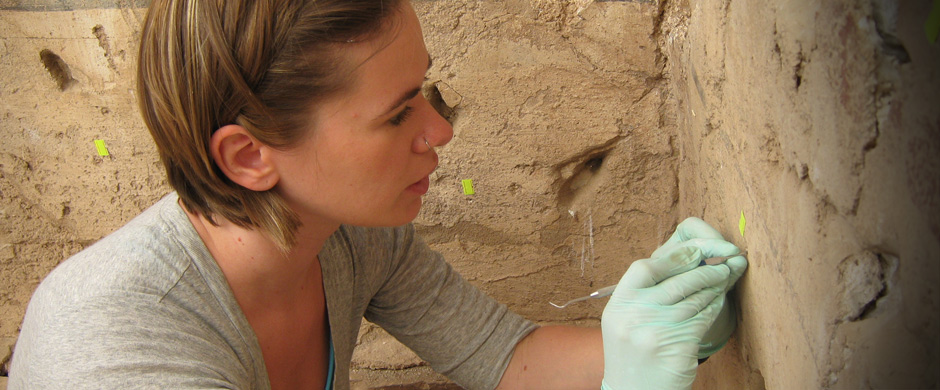 | IN THE LAB
| IN THE LAB

Practical Training
Project-based instruction plays an important role in the development of a well-rounded conservator as it allows students to develop technical abilities and collaborative skills in the workplace. To this end, the Conservation Center facilitates the design of practical training opportunities for students during the summer and in the winter intersession at archaeological excavations, museums, and historic houses such as Villa La Pietra, NYU’s campus in Florence, Italy.
Archaeological Excavations
For over 45 years, Conservation Center students have spent their summers working at Institute-sponsored excavations, such as Aphrodisias in Turkey, the Sanctuary of the Great Gods on Samothrace in Greece, and Selinunte in Italy. During the winter, advanced objects students are able to participate in the excavations at Abydos in Egypt. Students who participate at archaeological sites carry out treatment of newly excavated materials (including metals, ceramics, glass, wall paintings, mosaics, stone, cartonnage and human burials) and of previously excavated and treated objects currently in storage or housed in on-site museums. They also consult with archaeologists and other specialists on handling and storage issues. Students are encouraged to think independently in designing and undertaking treatments, and gain experience in the adaption of techniques learned in the classroom to new and changing “real life” situations. In addition to treatment, students also have the opportunity to assess the success of past conservation treatments.
NYU students also serve as part of the conservation team at the Harvard University sponsored excavation at Sardis in Turkey. Students have the option to join excavations directed by other universities in their field of study as well. In recent years, students have participated at archaeological sites in Italy, Crete, Cyprus, China, Greece, and Tunisia.
Villa La Pietra
New York University’s Florentine campus, Villa La Pietra, is another breathtaking locale for work opportunities. Bequeathed to the University in 1994 by Sir Harold Acton, the Villa houses an extensive and relatively unrestored collection of early Italian paintings, textiles, sculpture, furniture, porcelains and more. Because the Villa’s collection is so vast and comprises a wide variety of materials, there are literally endless possibilities for education and training. Conservation Center faculty, along with Villa consultants and local conservators, are responsible for the care of the collection. Student projects, lasting anywhere from one week to one month, focus on the treatment of artifacts, the survey of the collection, and providing on-going maintenance of the estate. Recently, the Institute has been able to support interdisciplinary research and study sessions at the Villa. Students are paired in teams of conservator-art historian to research both historical and material aspects of the works of art in the collection using the curatorial files at the Villa, the library and photo archives at the Kunsthistorisches Institut in Florence, and the library at Villa I Tatti.
Summer Internships
In addition to NYU-sponsored activities, students are able to choose among a host of exciting summer work opportunities at museums, historic houses, and conservation labs where they can reinforce and develop the skills they acquire in the classroom. Although it is not required, many students opt to spend part or all of their summer interning at a conservation establishment in the US or abroad. Recent internship locations include the Los Angeles County Museum of Art; the Norse Folk Museum in Oslo, Norway; the Bishop Museum in Honolulu, Hawaii; the Museum of Fine Arts, Boston; the Wallraf-Richartz-Museum, Cologne; Victoria Hall Memorial, India; Royal Picture Gallery Mauritshuis, The Netherlands; the Walter’s Art Gallery, Baltimore; and the Museo del Prado, Madrid, Spain.
Short Courses and Special Programs
Various short courses are held annually to supplement the curriculum.
Archaeological Field School
In advance of the summer field season, the Center annually holds an intensive week-long workshop that emphasizes the application of sound conservation methodology under less-than-ideal conditions. Coordinated by Anna Serotta, consulting conservator for the excavations at Selinunte, students participate in lectures and labs by leading archaeological conservators. Topics of discussion focus on technical, ethical and practical issues students will likely face in archaeological fieldwork in the Mediterranean. The workshop includes hands-on exercises, problem solving, and student presentations, in conjunction with directed readings and seminars. This workshop is open to students from the other graduate programs in conservation.
History of Book Structures Practicum
This in-depth, four-week summer course provides an overview to the history and materials of bookbinding through detailed practice and study of selected historical binding structures and techniques. Students gain a thorough understanding of bookbinding construction through all historical periods by practicing methods of sewing, spine shaping, covering, endbanding and binding in boards of several broad binding types.